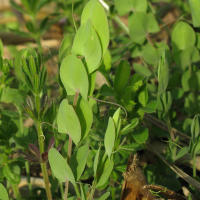Yellow pea
Lathyrus aphaca
Lathyrus aphaca, commonly known as yellow pea, yellow vetchling, or yellow everlasting pea, is a flowering plant species belonging to the legume family, Fabaceae. It is native to various regions of Europe and Asia and is known for its distinctive yellow flowers. Here is a description of Lathyrus aphaca:
Appearance:
- Yellow pea is an annual or biennial herb that typically grows as a climbing or trailing vine.
- The plant's leaves are pinnately compound, with several pairs of leaflets. The leaflets are typically small and ovate.
- The flowers of Lathyrus aphaca are bright yellow and have a distinct pea-flower shape, with a standard petal, wing petal, and keel petal.
- The plant produces pods containing seeds, which are typically brown or black.
Habitat:
- Yellow pea is often found in a variety of habitats, including grasslands, meadows, roadsides, and disturbed areas.
- It can tolerate a range of soil types and is often seen in sunny to partially shaded locations.
Lifecycle:
- Lathyrus aphaca is an annual or biennial plant, depending on environmental conditions.
- It reproduces by seed, with the seeds being contained in pods produced by the plant.
Ecological Role:
- Yellow pea is a legume, which means it has a symbiotic relationship with nitrogen-fixing bacteria in its root nodules. This ability to fix nitrogen can improve soil fertility.
- It provides forage for various herbivores and pollinators, including bees and butterflies.
Uses:
- Historically, yellow pea has been used as a forage crop for livestock, providing nutritious and palatable grazing.
- In some regions, it has been cultivated as a green manure or cover crop to improve soil quality.
- The bright yellow flowers and vining growth habit also make it an attractive addition to gardens.
Control:
- In agricultural contexts, yellow pea is not typically considered a weed but may be managed as a cover crop or forage crop to support soil health.
Lathyrus aphaca is a versatile plant that has been utilized in various ways, from forage and green manure to its decorative use in gardens. Its ability to improve soil quality and support pollinators makes it a valuable addition to agricultural and ecological systems.
















Prodotti fitosanitari
- N/A
- N/A
- N/A
- N/A
- N/A